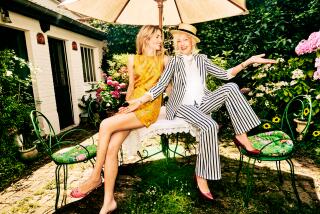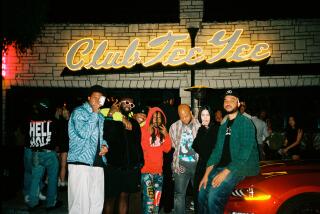RAW STOCKS
- Share via
In 1966, Gary Lee Boas walked past the hospital in his hometown of Lancaster, Pa., and noticed a commotion of popping flashbulbs. “They were photographing a person I recognized as being a singer I saw on ‘The Mike Douglas Show,’ ” he says. “Well, it was Robert Goulet. I didn’t know his name, but I knew it was someone famous.” Fifteen years old and starved for the slightest brush with fame, Boas ran home, grabbed his cheap Brownie Hawkeye camera and returned to the hospital. “It ended up that I spent my whole day following this man around to get pictures. All I know is that it jazzed me. I didn’t even know who the hell he was.”
The Goulet encounter spawned a lifelong obsession with photographing the famous. Within weeks, he persuaded his mother, Mary, to drive him two hours away to Philadelphia so that he could haunt stage doors at the city’s playhouse and at “The Mike Douglas Show.” There he scored snapshots of stars he’d actually heard of--Sally Kellerman, Mary Tyler Moore, Richard Chamberlain. “I was standing with these people I googled over on TV, and they were in front of me, never even dreaming that these people were accessible.” There was no turning back. Eventually, like the best of those shows, Boas headed for Broadway. Over the years, Boas and his Brownie (and later a Keystone and various other over-the-counter cameras) would capture tens of thousands of celebrities, some of them blurred, off-kilter or with red flashbulb eyes, and some--die-hard fan that he is--with himself in the shot as well.
Along the way, he befriended many of the celebrities he had adored from afar. Lucille Ball: “She wouldn’t have plastic surgery done, so she wore tape,” he recalls. Katharine Hepburn: “With her, we fought and we made up.” Julie Christie: “I can’t remember how it got from ‘Here’s a pen, here’s a paper, sign it,’ to [her saying] ‘Oh, here’s the phone number, call me up at the hotel.’ ” Even a post-Watergate Richard Nixon: “He was kind of a lost soul, but I think he and I connected.” (Like fellow Pennsylvanian Andy Warhol, whom he photographed, Boas worshiped celebrityhood without regard for what brought about that fame). To this day, he has never officially moved out of the Lancaster bedroom he grew up in, which is piled high with photo albums, signed playbills and mounds of other mementos. The cream of his collection--500 pictures--and a number of choice reminiscences were culled for the book “Starstruck: Photographs From a Fan,” to be released this month by Dilettante Press. The book cuts off at 1980, Boas says, because the publishers were “overwhelmed by my collection.”
Of course, this was before the John Lennon assassination, celebrity stalking trials, paparazzi stakeouts and the concurrent commodification and management of every second of celebrity exposure. “Today the fan barely exists,” Boas, 48, mourns. “Even if you are a fan, you can’t get near the celebrities. It’s crazy.” He now works for a photo agency, reserves a spot on the red carpet and lugs a $1,500 Canon 10-S. Shooting for the dollar, he says, means he’ll often crop out or soft-focus the background elements that made his Brownie pics such nostalgic verite. “The sad part, when I come out to L.A. and go to work, I just know that I’m going to have some kind of negative encounter with somebody,” he laments. “Very rarely the celebrity. It’s usually their publicist. Or an overzealous security guard. Or even a fellow photographer.”


